RISE: Rolling-Inspired Scheduling for Emergency Tasks by Heterogeneous UAVs
Abstract
1. Introduction
- The rationality of task scheduling. The tasks that will be assigned should be compatible with the UAV performance. For example, the UAV that carries materials can carry out the tasks of distribution and rescue. However, most of the existing task scheduling schemes fail to establish a certain mapping relationship between tasks and UAVs, which prevents the performance of UAVs from meeting the requirements of the tasks that are assigned to them, ultimately leading to task rejection or execution delays that have an impact on the multi-UAV system’s overall efficiency.
- The adaptability of task scheduling. The arrival of emergency tasks and the depletion of UAV energy frequently occur during the task execution of the multi-UAV system. Some methods build task scheduling models based on the known task environment but lack dynamic scheduling mechanisms that can adapt to the changes in the environment. Once an emergency occurs, the established scheme cannot be applied to the changed scenario, which easily leads to the problems of low task completion rate and low utilization rate of UAVs.
- We construct an optimal scheduling framework for emergency tasks, which is mainly composed of two phases: task clustering and optimization scheduling. It can rapidly generate scheduling schemes for tasks that arrive in the system dynamically.
- We devise a task clustering strategy inspired from a density peaks (DP)-based clustering method, which realizes the reasonable grouping of dynamic tasks by constructing a distance matrix based on multiple task attributes.
- We present a dynamic task scheduling model for heterogeneous UAVs. We create an objective function that takes the value and completion probability as the task profit, and it also takes the safety risk and energy consumption as the UAV flight cost. Furthermore, a task allocation strategy based on the rolling optimization idea is designed to improve the execution efficiency of emergency tasks.
2. Related Work
3. System Framework and Problem Statement
3.1. Framework
3.2. Problem Statement
3.2.1. Problem Assumption
- (1)
- Each task can be accomplished by at most one UAV.
- (2)
- The assignment result of UAVs is regarded as the access to the positions of a series of task points.
- (3)
- When the UAVs land at the base stations, they will finish replenishing the resources within a fixed time period (only considering two types of resources: battery and supply).
- (4)
- UAVs carry out tasks at the same altitude. The 2D coordinates of rescue tasks are considered to improve the timeliness of task allocation.
3.2.2. Basic Model
- (1)
- Task model: there are two sorts of scheduled tasks in the system: general tasks and emergency tasks. The urgency of emergency tasks is greater and their deadlines are shorter than general tasks: indicates the general task set, and indicates the emergency task set. Both types of tasks have five characteristics. Each can be modeled by where they are represented in order by task number, task position, the number of resource requirements, arrival time, and deadline of task , respectively.
- (2)
- UAV model: the platform model in the system is defined as a group of heterogeneous UAVs . To further describe the characteristics of the UAV formation, each UAV can be featured by a tuple in which they indicate UAV number, UAV type, UAV position, the number of resources, maximum flight mileage, UAV velocity, and flight time, respectively.
- (3)
- Base station: the role of the base station is to provide resources for UAVs, mainly including batteries and rescue materials. Let be the set of base station, each station can be represented by , where is the station number, is the station position, and is the service time of .
4. Modeling and Formulation
4.1. Objective Function
4.2. Constraints
5. Emergency Task Scheduling Method
5.1. Improved DP-Based Task Clustering
- (1)
- It can effectively avoid the generation of halo points and ensure the accuracy and rationality of task clustering.
- (2)
- The number of members in each cluster is more balanced, which can effectively solve the problems of low platform utilization and low task completion rate.
5.2. Rolling-Inspired Optimization Scheduling
5.2.1. Task-UAV Adapter
5.2.2. Emergency Task Manager
5.2.3. Rolling Queue Generator
- (1)
- If fails to meet C4, cannot perform tasks. This phenomenon indicates that needs to fly to the nearest base station for supplemental energy. Because its position has changed after arriving at the base station, the tasks in the rolling queue must be reordered so that the task with the highest importance score is completed first.
- (2)
- If fails to meet C5, cannot perform tasks. There are two factors that contribute to this occurrence. One is that if the initial resource of is insufficient to meet the requirement of , then should be assigned to other UAVs that meet C5 and C6, and it will be deleted from the queue. If not, will be rejected. The second is that the needs to fly to the nearest base station for supplemental energy. The tasks in the rolling queue need to be reordered just as in (1).
- (3)
- If meets C4 and C5, is scheduled to carry out this task, and will be removed from the queue.
- (1)
- The dynamic optimization problem is transformed into multiple local optimization problems by fully considering the profits and costs of task execution, which can effectively reduce the cost of optimal scheduling and enhance task execution feasibility.
- (2)
- The tasks with the earliest deadline are scheduled first to ensure the overall success rate of task execution.
- (3)
- Tasks are awaiting execution in the rolling queue. There is no migration overhead caused after rescheduling, effectively lowering the energy consumption of system scheduling.
5.3. Algorithm Implementation
| Algorithm 1: RISE |
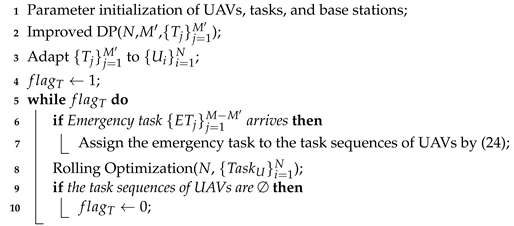 |
| Algorithm 2: Improved DP() |
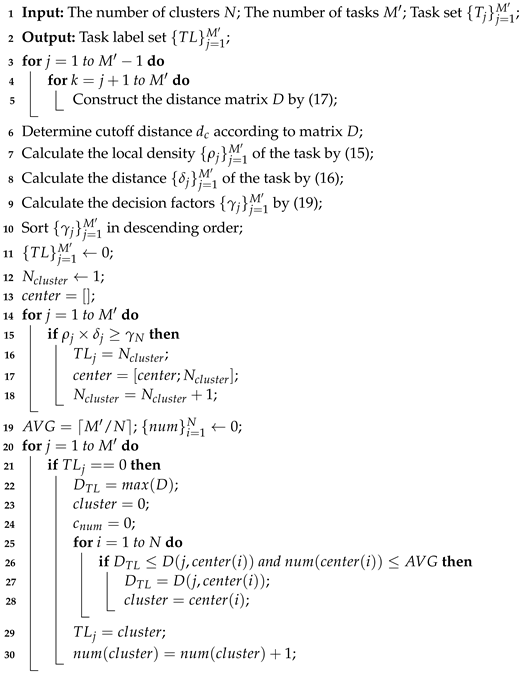 |
| Algorithm 3: Rolling Optimization() |
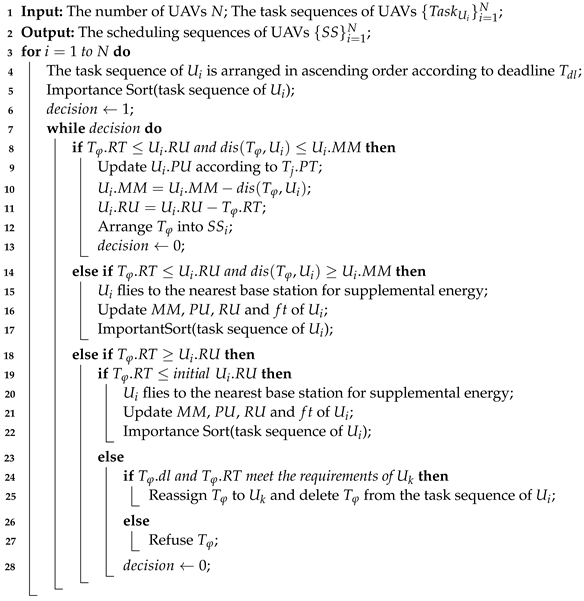 |
| Algorithm 4: Importance Sort() |
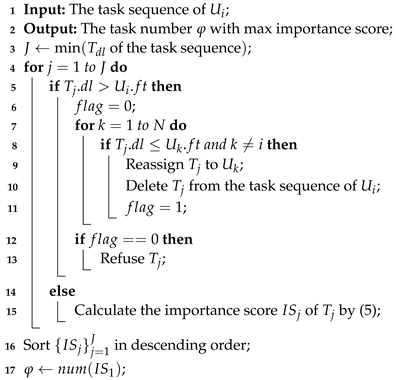 |
6. Experiment Results
6.1. Performance Evaluation
6.2. Extended Experimental Analysis
6.2.1. RISE Superiority Discussion
6.2.2. RISE Scalability Discussion
7. Conclusions
Author Contributions
Funding
Institutional Review Board Statement
Informed Consent Statement
Data Availability Statement
Conflicts of Interest
References
- Zhu, L.; Wang, Y.; Wu, Z. An Adaptive Priority Allocation for Formation UAVs in Complex Context. IEEE Trans. Aerosp. Electron. Syst. 2021, 57, 1002–1015. [Google Scholar] [CrossRef]
- Chai, X.; Zheng, Z.; Xiao, J.; Yan, L.; Qu, B.; Wen, P.; Wang, H.; Zhou, Y.; Sun, H. Multi-Strategy Fusion Differential Evolution Algorithm for UAV Path Planning in Complex Environment. Aerosp. Sci. Technol. 2022, 121, 107287. [Google Scholar] [CrossRef]
- Wu, Y.; Low, K.H.; Lv, C. Cooperative Path Planning for Heterogeneous Unmanned Vehicles in a Search-and-Track Mission Aiming at an Underwater Target. IEEE Trans. Veh. Technol. 2020, 69, 6782–6787. [Google Scholar] [CrossRef]
- Zhen, Z.; Chen, Y.; Wen, L.; Han, B. An Intelligent Cooperative Mission Planning Scheme of UAV Swarm in Uncertain Dynamic Environment. Aerosp. Sci. Technol. 2020, 100, 105826. [Google Scholar] [CrossRef]
- Li, X.; Wu, L.; Niu, Y.; Ma, A. Multi-Target Association for UAVs Based on Triangular Topological Sequence. Drones 2022, 6, 119. [Google Scholar] [CrossRef]
- Yin, Y.; Guo, Y.; Su, Q.; Wang, Z. Task Allocation of Multiple Unmanned Aerial Vehicles Based on Deep Transfer Reinforcement Learning. Drones 2022, 6, 215. [Google Scholar] [CrossRef]
- Rahim, S.; Razaq, M.M.; Chang, S.Y.; Peng, L. A Reinforcement Learning-Based Path Planning for Collaborative UAVs. In Proceedings of the 37th ACM/SIGAPP Symposium on Applied Computing, Xiamen, China, 5–8 March 2021; pp. 1938–1943. [Google Scholar]
- Zhang, K.; Li, Z.; Zhao, X.; Zhao, B. Dynamic Multi-UAV Cooperative Reconnaissance Task Assignment Based on ICNP. In Proceedings of the 2020 5th International Conference on Mechanical, Control and Computer Engineering (ICMCCE), Harbin, China, 25–27 December 2020; pp. 773–779. [Google Scholar]
- Edison, E.; Shima, T. Integrated Task Assignment and Path Optimization for Cooperating Uninhabited Aerial Vehicles using Genetic Algorithms. Comput. Oper. Res. 2011, 38, 340–356. [Google Scholar] [CrossRef]
- Yao, P.; Wang, H.; Ji, H. Multi-UAVs Tracking Target in Urban Environment by Model Predictive Control and Improved Grey Wolf Optimizer. Aerosp. Sci. Technol. 2016, 55, 131–143. [Google Scholar] [CrossRef]
- Wang, Y.; Ru, Z.; Wang, K.; Huang, P. Joint Deployment and Task Scheduling Optimization for Large-Scale Mobile Users in Multi-UAV-Enabled Mobile Edge Computing. IEEE Trans. Cybern. 2020, 50, 3984–3997. [Google Scholar] [CrossRef]
- Xiang, C.; Hao, P.; Zhang, X. The Path Planning Study of Multi-Task Logistics UAVs Under Complex Low Airspace. In Proceedings of the 2021 33rd Chinese Control and Decision Conference (CCDC), Kunming, China, 22–24 May 2021; pp. 5238–5242. [Google Scholar]
- Ribeiro, R.G.; Cota, L.P.; Euzébio, T.A.M.; Ramírez, J.A.; Guimaraes, F.G. Unmanned-Aerial-Vehicle Routing Problem with Mobile Charging Stations for Assisting Search and Rescue Missions in Postdisaster Scenarios. IEEE Trans. Syst. Man Cybern. Syst. 2022, 52, 6682–6696. [Google Scholar] [CrossRef]
- Yin, Y.; Yin, Y.; Lv, Q.; Cheng, P.; Wu, P.; Zhu, M. Multi-UAV Cooperative Task Allocation Method for Intensive Corridors of Transmission Lines Inspection. In Proceedings of the 2021 IEEE International Conference on Computer Science, Electronic Information Engineering and Intelligent Control Technology (CEI), Fuzhou, China, 24–26 September 2021; pp. 203–208. [Google Scholar]
- Semiz, F.; Polat, F. Solving the Area Coverage Problem with UAVs: A Vehicle Routing with Time Windows Variation. Robot. Auton. Syst. 2020, 126, 103435. [Google Scholar] [CrossRef]
- Yao, J.; Ansari, N. Online Task Allocation and Flying Control in Fog-Aided Internet of Drones. IEEE Trans. Veh. Technol. 2020, 69, 5562–5569. [Google Scholar] [CrossRef]
- Zhang, J.; Wu, Y.; Min, G.; Hao, F.; Cui, L. Balancing Energy Consumption and Reputation Gain of UAV Scheduling in Edge Computing. IEEE Trans. Cogn. Commun. Netw. 2020, 6, 1204–1217. [Google Scholar] [CrossRef]
- Liu, D.; Bao, W.; Zhu, X.; Fei, B.; Men, T.; Xiao, Z. Cooperative Path Optimization for Multiple UAVs Surveillance in Uncertain Environment. IEEE Internet Things J. 2022, 9, 10676–10692. [Google Scholar] [CrossRef]
- Wu, H.; Li, H.; Xiao, R.; Liu, J. Modeling and Simulation of Dynamic Ant Colony’s Labor Division for Task Allocation of UAV Swarm. Phys. A Stat. Mech. Its Appl. 2018, 491, 127–141. [Google Scholar] [CrossRef]
- Chen, Y.; Yang, D.; Yu, J. Multi-UAV Task Assignment with Parameter and Time-Sensitive Uncertainties Using Modified Two-Part Wolf Pack Search Algorithm. IEEE Trans. Aerosp. Electron. Syst. 2018, 54, 2853–2872. [Google Scholar] [CrossRef]
- Zhang, Z.; Li, J.; Wang, J. Sequential Convex Programming for Nonlinear Optimal Control Problems in UAV Path Planning. Aerosp. Sci. Technol. 2018, 76, 280–290. [Google Scholar] [CrossRef]
- Wang, L.; Yang, D.; Han, X.; Zhang, D.; Ma, X. Mobile Crowdsourcing Task Allocation with Differential-and-Distortion Geo-Obfuscation. IEEE Trans. Dependable Secur. Comput. 2021, 18, 967–981. [Google Scholar] [CrossRef]
- Lippi, M.; Marino, A. A Mixed-Integer Linear Programming Formulation for Human Multi-Robot Task Allocation. In Proceedings of the 30th IEEE International Conference on Robot & Human Interactive Communication (RO-MAN), Vancouver, BC, Canada, 8–12 August 2021; pp. 1017–1023. [Google Scholar]
- You, W.; Dong, C.; Wu, Q.; Qu, Y.; Wu, Y.; He, R. Joint Task Scheduling, Resource Allocation, and UAV Trajectory Under Clustering for FANETs. China Commun. 2022, 19, 104–118. [Google Scholar] [CrossRef]
- Chen, J.; Du, C.; Zhang, Y.; Han, P.; Wei, W. A Clustering-Based Coverage Path Planning Method for Autonomous Heterogeneous UAVs. IEEE Trans. Intell. Transp. Syst. 2021. [Google Scholar] [CrossRef]
- Chen, J.; Zhang, Y.; Wu, L.; You, T.; Ning, X. An Adaptive Clustering-Based Algorithm for Automatic Path Planning of Heterogeneous UAVs. IEEE Trans. Intell. Transp. Syst. 2022, 23, 16842–16853. [Google Scholar] [CrossRef]
- Wu, L.; Sun, Q.; Xu, H.; Song, X.; Zhang, Y. Design of Hybrid Simulated Annealing Algorithm for UAV Scheduling Based on Coordinated Task Scheduling. In Proceedings of the 40th Chinese Control Conference, Shanghai, China, 26–28 July 2021; pp. 494–499. [Google Scholar]
- Zhu, M.; Du, X.; Zhang, X.; Luo, H.; Wang, G. Multi-UAV Rapid-Assessment Task-Assignment Problem in a Post-Earthquake Scenario. IEEE Access 2019, 7, 74542–74557. [Google Scholar] [CrossRef]
- Zhen, Z.; Xing, D.; Gao, C. Cooperative Search-Attack Mission Planning for Multi-UAV Based on Intelligent Self-Organized Algorithm. Aerosp. Sci. Technol. 2018, 76, 402–411. [Google Scholar] [CrossRef]
- Chen, J.; Ling, F.; Zhang, Y.; You, T.; Liu, Y.; Du, X. Coverage Path Planning of Heterogeneous Unmanned Aerial Vehicles Based on Ant Colony System. Swarm Evol. Computat. 2022, 69, 101005. [Google Scholar] [CrossRef]
- Liu, H.; Li, X.; Wu, G.; Fan, M.; Wang, R.; Gao, L.; Pedrycz, W. An Iterative Two-Phase Optimization Method Based on Divide and Conquer Framework for Integrated Scheduling of Multiple UAVs. IEEE Trans. Intell. Transp. Syst. 2021, 22, 5926–5938. [Google Scholar] [CrossRef]
- Huang, H.; Hu, C.; Zhu, J.; Wu, M.; Malekian, R. Stochastic Task Scheduling in UAV-Based Intelligent On-Demand Meal Delivery System. IEEE Trans. Intell. Transp. Syst. 2022, 23, 13040–13054. [Google Scholar] [CrossRef]
- Hu, J.; Wu, H.; Zhan, R.; Menassel, R.; Zhou, X. Self-Organized Search-Attack Mission Planning for UAV Swarm Based on Wolf Pack Hunting Behavior. J. Syst. Eng. Electron. 2021, 32, 1463–1476. [Google Scholar]
- Liu, D.; Bao, W.; Fei, B.; Zhu, X.; Xiao, Z.; Men, T. Multi-UAV Cooperative Obstacle Avoidance and Surveillance in Intelligent Transportation. In Proceedings of the IEEE 20th International Conference on Trust, Security and Privacy in Computing and Communications (TrustCom), Shenyang, China, 20–22 October 2021; pp. 1013–1020. [Google Scholar]
- Fei, B.; Bao, W.; Zhu, X.; Liu, D.; Men, T.; Xiao, Z. Autonomous Cooperative Search Model for Multi-UAV with Limited Communication Network. IEEE Internet Things J. 2022, 9, 19346–19361. [Google Scholar] [CrossRef]
- Duan, H.; Zhao, J.; Deng, Y.; Shi, Y.; Ding, X. Dynamic Discrete Pigeon-Inspired Optimization for Multi-UAV Cooperative Search-Attack Mission Planning. IEEE Trans. Aerosp. Electron. Syst. 2021, 57, 706–720. [Google Scholar] [CrossRef]
- Zhou, L.; Leng, S.; Liu, Q.; Wang, Q. Intelligent UAV Swarm Cooperation for Multiple Targets Tracking. IEEE Internet Things J. 2021, 9, 743–754. [Google Scholar] [CrossRef]
- Yu, X.; Gao, X.; Wang, L.; Wang, X.; Ding, Y.; Lu, C.; Zhang, S. Cooperative Multi-UAV Task Assignment in Cross-Regional Joint Operations Considering Ammunition Inventory. Drones 2022, 6, 77. [Google Scholar] [CrossRef]
- Su, Z.; Wang, Y.; Xu, Q.; Zhang, N. LVBS: Lightweight Vehicular Blockchain for Secure Data Sharing in Disaster Rescue. IEEE Trans. Dependable Secur. Comput. 2022, 19, 19–32. [Google Scholar] [CrossRef]
- Wang, Y.; Su, Z.; Xu, Q.; Li, R.; Luan, T.H. Lifesaving with RescueChain: Energy-Efficient and Partition-Tolerant Blockchain Based Secure Information Sharing for UAV-Aided Disaster Rescue. In Proceedings of the IEEE INFOCOM 2021-IEEE Conference on Computer Communications, Vancouver, BC, Canada, 10–13 May 2021; pp. 1–10. [Google Scholar]
- Rodriguez, A.; Laio, A. Clustering by Fast Search and Find of Density Peaks. Science 2014, 344, 1492–1496. [Google Scholar] [CrossRef] [PubMed]
- Fei, B.; Liu, D.; Zhou, J.; Bao, W.; Chen, F.; Zhang, H. A Spectral Clustering Enabled Dynamic Task Allocation Approach of Multiple UAVs. In Proceedings of the 8th International Conference on Big Data and Information Analytics (BigDIA), Guiyang, China, 24–25 August 2022; pp. 408–415. [Google Scholar]
- Bezdek, J.C.; Ehrlich, R.; Full, W. FCM: The fuzzy C-Means Clustering Algorithm. Comput. Geosci. 1984, 10, 191–203. [Google Scholar] [CrossRef]
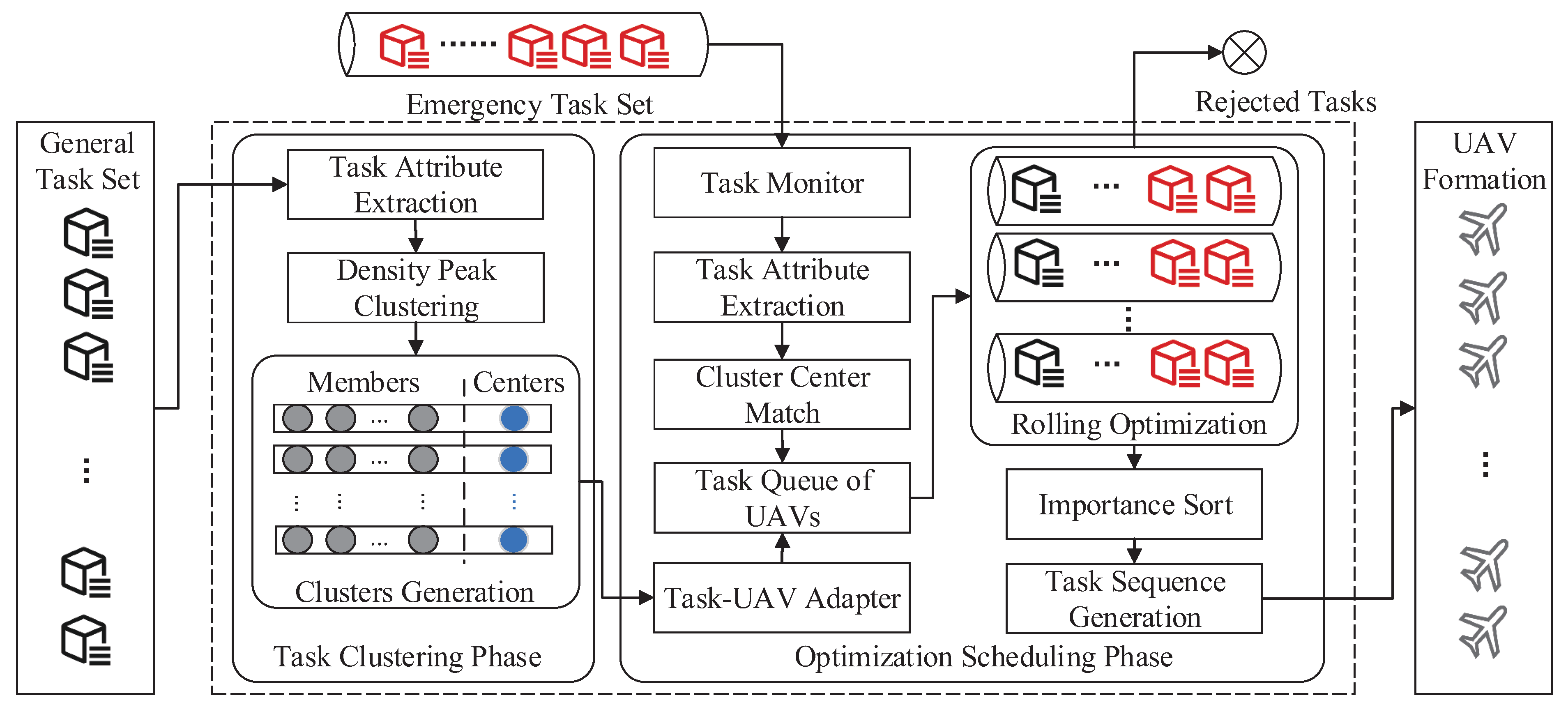
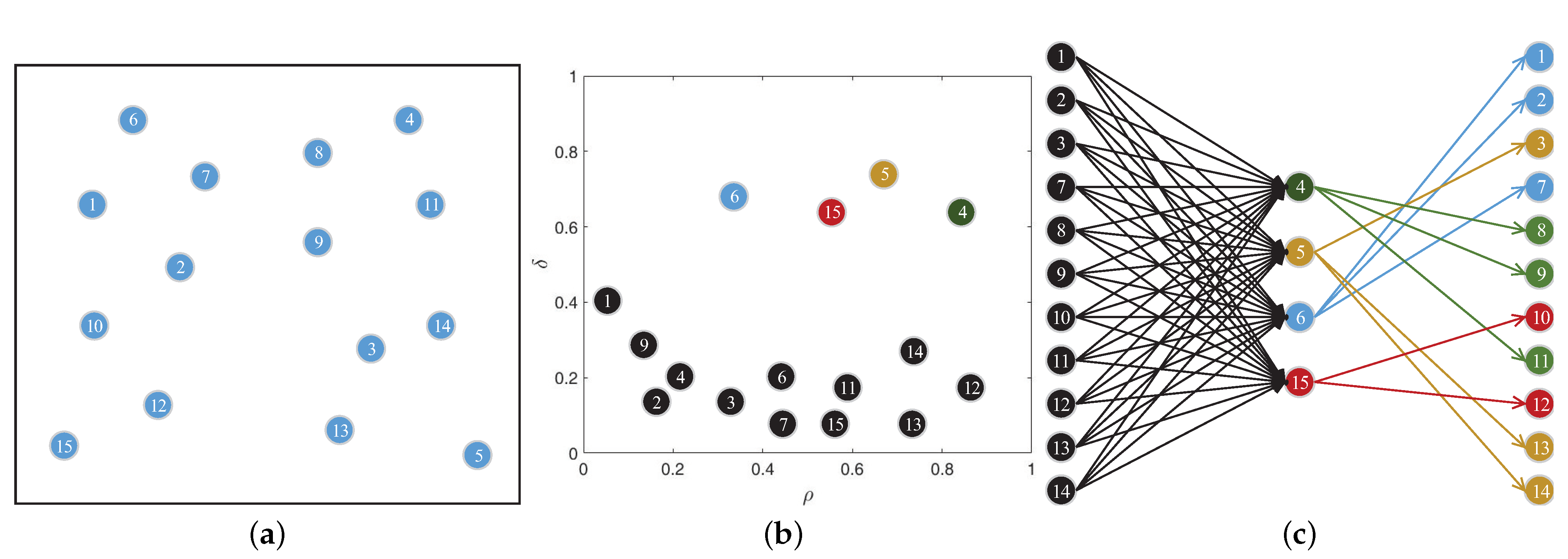




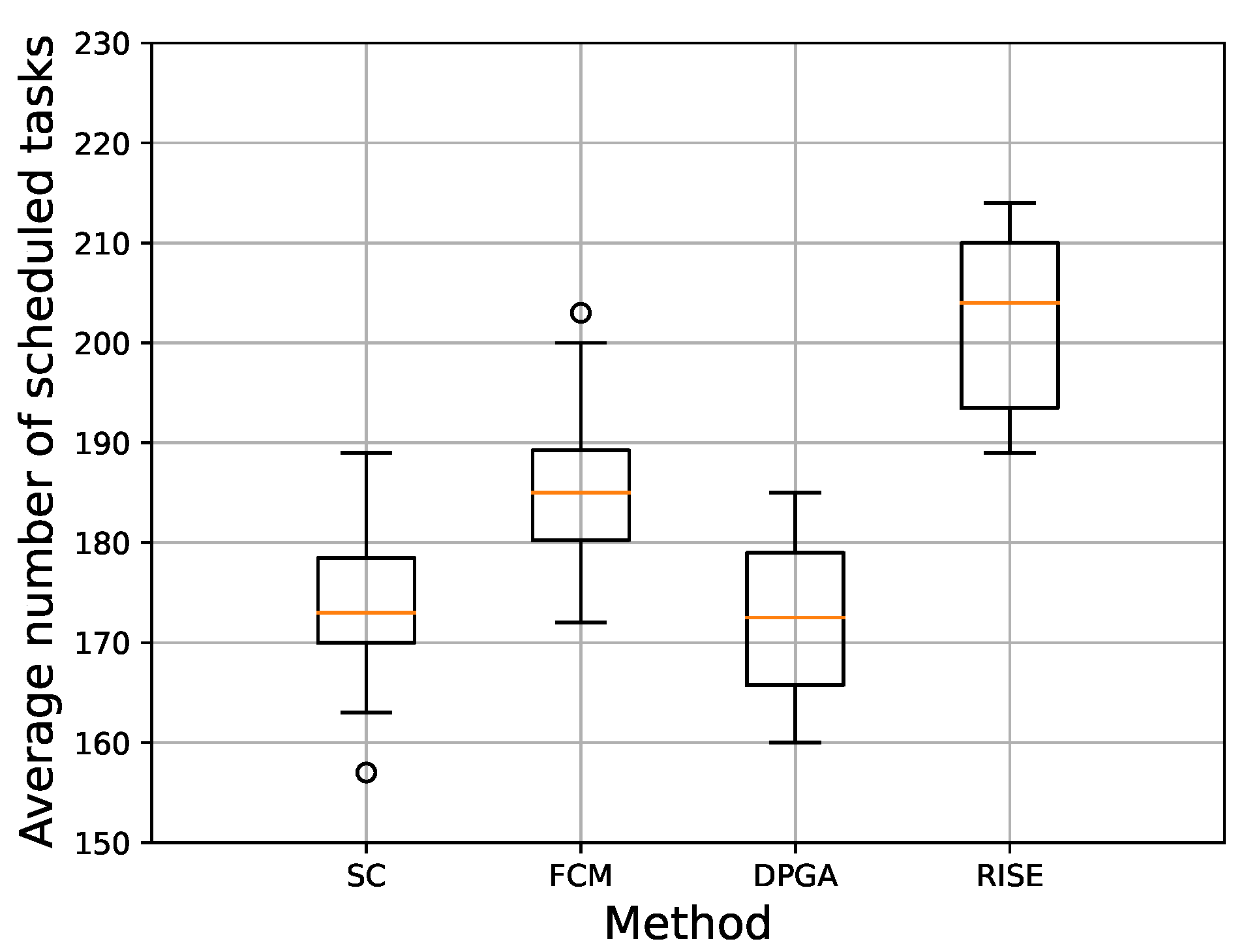
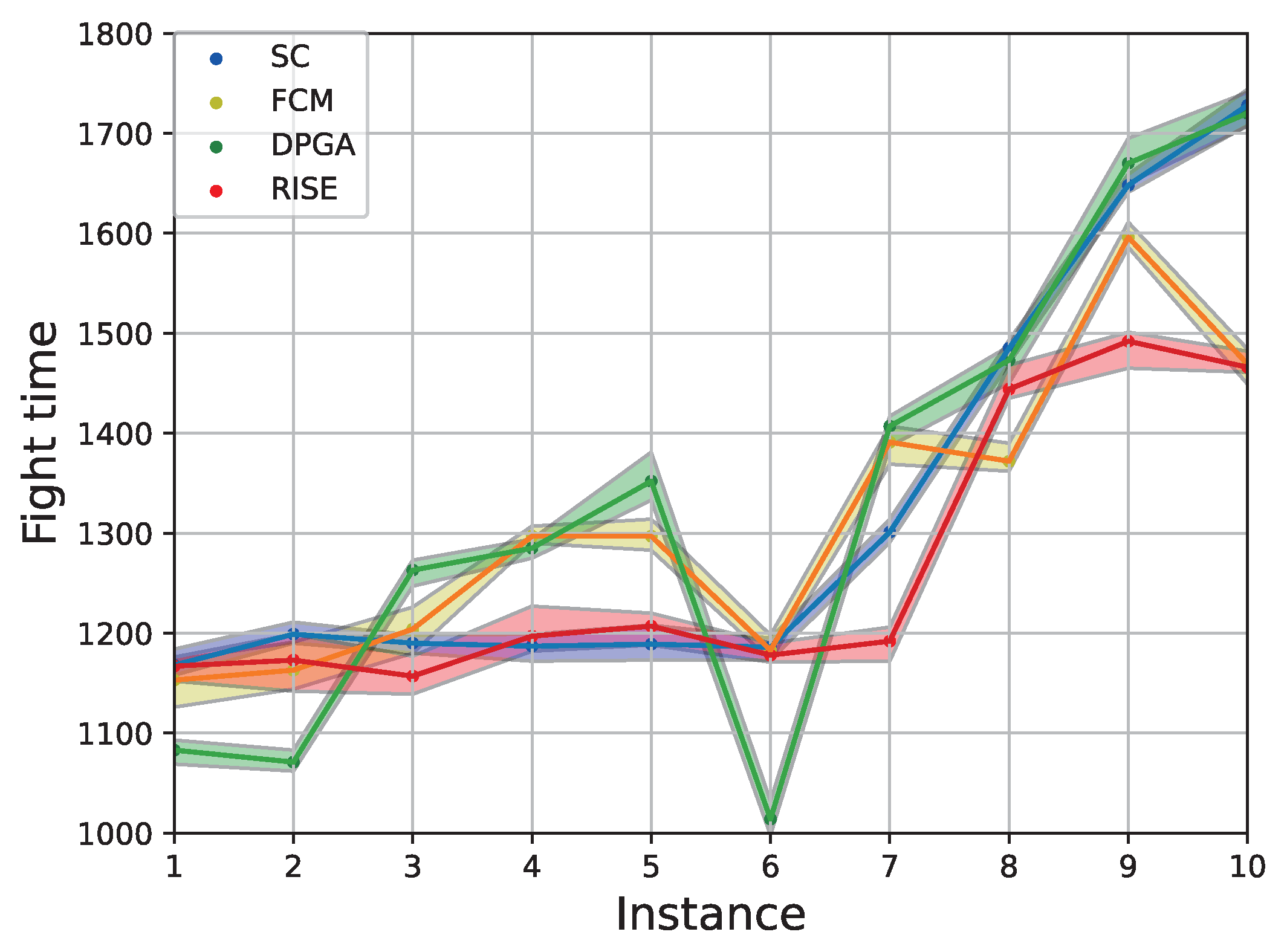
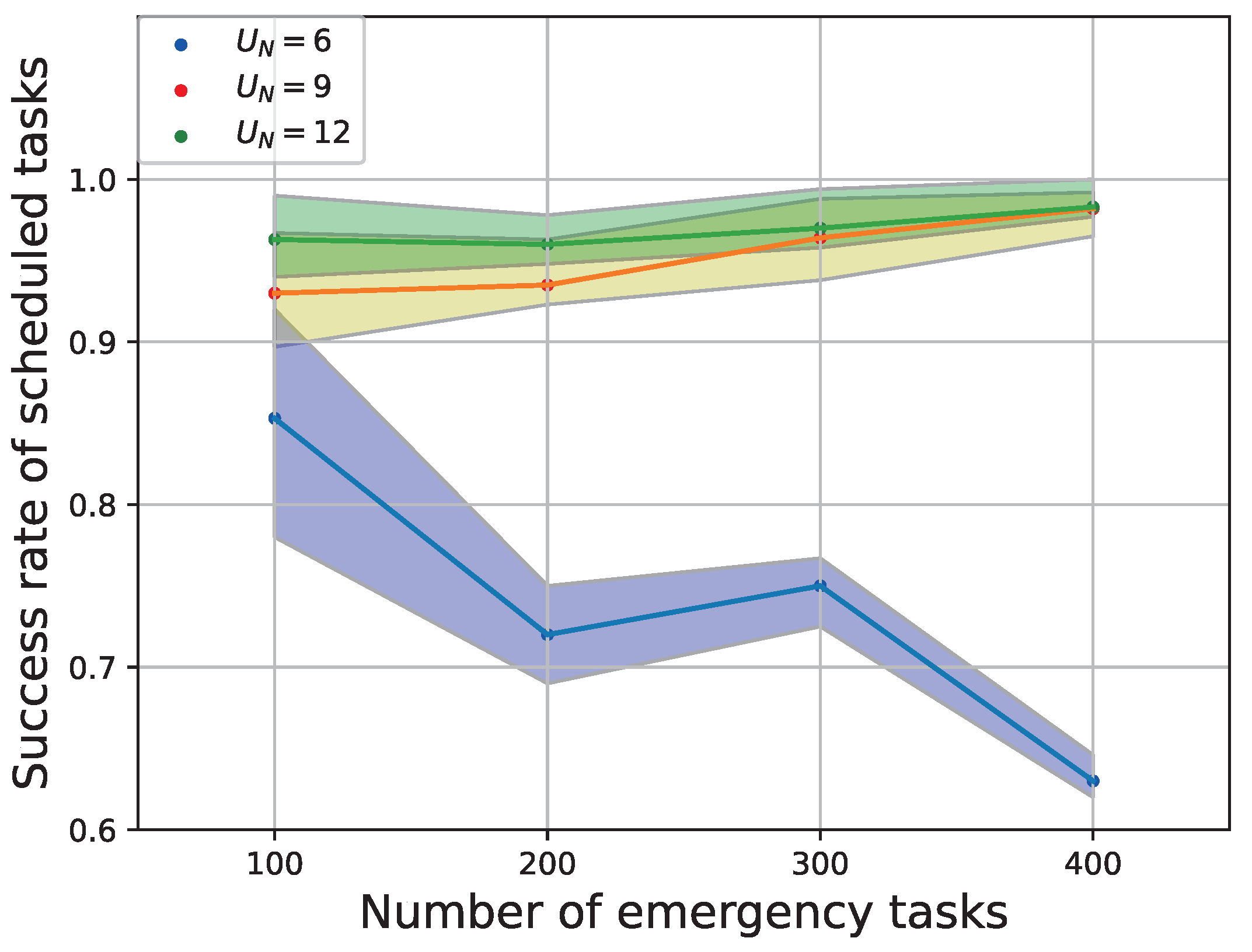
| Method | Literature | Tasks | UAVs | Dynamic Tasks | Base Station |
|---|---|---|---|---|---|
| Optimization | [18] | Single type | Heterogeneous | No | No |
| [24] | Single type | Heterogeneous | Yes | No | |
| [25] | Single type | Heterogeneous | No | No | |
| Heuristics | [30] | Single type | Heterogeneous | No | No |
| [31] | Single type | Heterogeneous | No | No | |
| [32] | Single type | Heterogeneous | Yes | Yes | |
| Swarm intelligence | [34] | Single type | Heterogeneous | No | No |
| [36] | Multi-type | Heterogeneous | No | No | |
| [38] | Multi-type | Heterogeneous | No | Yes |
| Notation | Definition |
|---|---|
| , , | the ith task, jth task, and kth task |
| the ith UAV | |
| , | the ith base station and qth base station |
| the task position, number of resource requirements, arrival time, | |
| and deadline of task | |
| the UAV position, number of resources, maximum flight mileage, | |
| UAV velocity, and flight time of | |
| the service time of | |
| the initial value of | |
| the completion probability of | |
| the energy consumption of per unit flight distance | |
| the Euclidean distance from to for | |
| the shortest plane distance from to | |
| the cutoff distance | |
| the life cycle difference and type difference between and after | |
| regularization | |
| the distance between and after regularization | |
| the maximum difference and minimum difference between the life | |
| cycles of and | |
| the maximum distance and minimum distance between and | |
| the capability value of | |
| the requirement value of ith task sequence | |
| the length of ith task sequence |
| ID | PU | RU(kg) | MM(km) | VU(m/s) | ft(s) |
|---|---|---|---|---|---|
| (0,0) | 25 | 100 | 50 | 0 | |
| (0,0) | 25 | 100 | 50 | 0 | |
| (0,0) | 15 | 250 | 50 | 0 | |
| (0,0) | 15 | 250 | 50 | 0 | |
| (0,0) | 20 | 200 | 50 | 0 | |
| (0,0) | 20 | 200 | 50 | 0 |
| ID | PB | st(s) |
|---|---|---|
| (5.4,2.4) | 30 | |
| (4.0,6.0) | 30 | |
| (10.8,6.0) | 30 |
| Method | Number of Scheduled Tasks | Number of Access to Base Stations | Running Time (s) | Flight Time of UAV Formation (s) |
|---|---|---|---|---|
| SC | 170 | 14 | 0.10 | 1198.22 |
| FCM | 182 | 14 | 0.18 | 1183.24 |
| DPGA | 172 | 15 | 4.07 | 1253.14 |
| RISE | 195 | 14 | 0.06 | 1149.27 |
| Method | SC | FCM | DPGA | RISE | |
|---|---|---|---|---|---|
| UAV ID | |||||
| 24 | 24 | 27 | 34 | ||
| 25 | 40 | 23 | 30 | ||
| 27 | 27 | 34 | 36 | ||
| 36 | 27 | 33 | 36 | ||
| 33 | 27 | 32 | 32 | ||
| 25 | 37 | 23 | 27 | ||
| Method | Maximum Number of Scheduled Tasks | Minimum Number of Scheduled Tasks | Average Number of Scheduled Tasks | Number of Accesses to Base Stations | Average Running Time (s) | Average Flight Time of UAV Formation (s) |
|---|---|---|---|---|---|---|
| SC | 189 | 157 | 170 | 15 | 0.12 | 1190 |
| FCM | 203 | 172 | 185 | 14 | 0.16 | 1204 |
| DPGA | 185 | 160 | 171 | 14 | 3.85 | 1263 |
| RISE | 214 | 189 | 203 | 14 | 0.05 | 1157 |
| Method | Instance | Number of | Number of | Number of | Number of Accesses | Running Time |
|---|---|---|---|---|---|---|
| General Tasks | Emergency Tasks | Scheduled Tasks | to Base Station | |||
| SC | I1 | 100 | 50 | |||
| I2 | 150 | 50 | ||||
| I3 | 200 | 50 | ||||
| I4 | 250 | 50 | ||||
| I5 | 300 | 50 | ||||
| I6 | 100 | 100 | ||||
| I7 | 150 | 100 | ||||
| I8 | 200 | 100 | ||||
| I9 | 250 | 100 | ||||
| I10 | 300 | 100 | ||||
| FCM | I1 | 100 | 50 | |||
| I2 | 150 | 50 | ||||
| I3 | 200 | 50 | ||||
| I4 | 250 | 50 | ||||
| I5 | 300 | 50 | ||||
| I6 | 100 | 100 | ||||
| I7 | 150 | 100 | ||||
| I8 | 200 | 100 | ||||
| I9 | 250 | 100 | ||||
| I10 | 300 | 100 | ||||
| DPGA | I1 | 100 | 50 | |||
| I2 | 150 | 50 | ||||
| I3 | 200 | 50 | ||||
| I4 | 250 | 50 | ||||
| I5 | 300 | 50 | ||||
| I6 | 100 | 100 | ||||
| I7 | 150 | 100 | ||||
| I8 | 200 | 100 | ||||
| I9 | 250 | 100 | ||||
| I10 | 300 | 100 | ||||
| RISE | I1 | 100 | 50 | |||
| I2 | 150 | 50 | ||||
| I3 | 200 | 50 | ||||
| I4 | 250 | 50 | ||||
| I5 | 300 | 50 | ||||
| I6 | 100 | 100 | ||||
| I7 | 150 | 100 | ||||
| I8 | 200 | 100 | ||||
| I9 | 250 | 100 | ||||
| I10 | 300 | 100 |
| Number of UAVs | Number of General Tasks | Number of Emergency Tasks | Number of Scheduled Tasks | Running Time |
|---|---|---|---|---|
| 200 | 100 | |||
| 200 | 200 | |||
| 200 | 300 | |||
| 200 | 400 | |||
| 200 | 100 | |||
| 200 | 200 | |||
| 200 | 300 | |||
| 200 | 400 | |||
| 200 | 100 | |||
| 200 | 200 | |||
| 200 | 300 | |||
| 200 | 400 |
Publisher’s Note: MDPI stays neutral with regard to jurisdictional claims in published maps and institutional affiliations. |
© 2022 by the authors. Licensee MDPI, Basel, Switzerland. This article is an open access article distributed under the terms and conditions of the Creative Commons Attribution (CC BY) license (https://creativecommons.org/licenses/by/4.0/).
Share and Cite
Fei, B.; Liu, D.; Bao, W.; Zhu, X.; Zou, M. RISE: Rolling-Inspired Scheduling for Emergency Tasks by Heterogeneous UAVs. Drones 2022, 6, 310. https://doi.org/10.3390/drones6100310
Fei B, Liu D, Bao W, Zhu X, Zou M. RISE: Rolling-Inspired Scheduling for Emergency Tasks by Heterogeneous UAVs. Drones. 2022; 6(10):310. https://doi.org/10.3390/drones6100310
Chicago/Turabian StyleFei, Bowen, Daqian Liu, Weidong Bao, Xiaomin Zhu, and Mingyin Zou. 2022. "RISE: Rolling-Inspired Scheduling for Emergency Tasks by Heterogeneous UAVs" Drones 6, no. 10: 310. https://doi.org/10.3390/drones6100310
APA StyleFei, B., Liu, D., Bao, W., Zhu, X., & Zou, M. (2022). RISE: Rolling-Inspired Scheduling for Emergency Tasks by Heterogeneous UAVs. Drones, 6(10), 310. https://doi.org/10.3390/drones6100310







